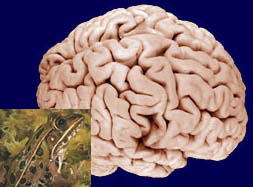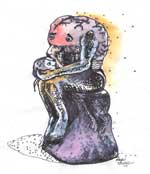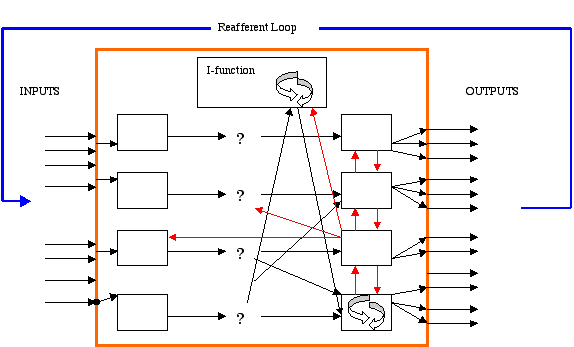Serendip is an independent site partnering with faculty at multiple colleges and universities around the world. Happy exploring!
Brain Behavior Institute - Session 7
|
|
 |
BRAIN AND BEHAVIOR INSTITUTE 2009Session 7 |
 |
Architecture: From the Output Side

- Bipartite : "I-function", nervous system as story teller
How many things are going on inside me that are so important to my existance that I have absolutely no control over? ... Jack
there are responses--conscious and unconscious to yesterday's session but they are being filtered by thoughts we are having about our thoughts. Teachers in particular learn to be very good screeners of our thoughts so that when people say the darndest things to us----we don't react--rather we redirect! I think we should scan some brains...I want to see what's going on in there! ... Deb
I am really intrigued by the possibility of conscious thoughts both supporting or combining with unconscious reactions and that conscious thoughts can impede or inhibit unconscious reactions ... Jill
What, indeed, does our conscious hold us back from? It obviously inhibits ideas because of social stigma, as we all experience in daily life, and as our discussion today about web creation brought up ... perhaps teachers can encourage public displays of ideas in order to increase confidence and lower the inhibition of the conscious over the unconscious, thus supporting the discussion of new ideas and overcoming social stigma ... Brie
Moving on - Additional architectual principles from looking at the output side ...
- Motor symphony
- Central pattern generation
- Gene/environment interactions
- Corollary discharge - role of motor control in perception
- Distributed control, who's running the show?
- Output associated with "expectation" or "model"
- Input as test of expectation/model
- Brain as explorer/scientist
- Action without "thinking", "I-function", story teller - preferable in some circumstances
- Purpose, expectation, creativity, exploration without "thinking", "I-function", story teller
- Damage to neocortex in humans leads to "paralysis"
- Loss of "willed movement"
- Loss of inhibition
- Motor cortex - "I-function"?
- I-function as a way to conceive new things?
Your thoughts in forum ... new understandings/questions? Relevance of all this to classroom?



Comments
Phantom limb, corallary discharge, and conductors
I am thinking about phantom limb and sensory deprivation. When we talked about sensory deprivation, we discussed how our brains are constantly generating and that it is the external inputs that keep the brain in check. Does phantom limb relate to this sensory deprivation? Is the brain constantly generating experiences for our body parts, and the external inputs from the sensory neurons is what inhibits or selects these experiences? Can some of the sensations felt in phantom limb be due to the lack of sensory input inhibiting what the brain is always generating?
While I agree that the human examples that Paul described do not have conductors. But I do think that many of them have either a catalyst or a leader. When we clapped, perhaps one person clapped first, or louder than the others, affecting the rest of us in a subtly way. Or walking down a busy street: one person will move first and others will respond, perhaps to multiple people at once. Is our job, as teachers, to serve as a catalytic source, or a source of leadership (one of many possible in the classrom), subtly guiding or steering the emergent learning, while placing most of the control on the students, in a "distributed control system"?
Music and I-Function
I'm waiting to see if the I-Function plays a part in music.
We discussed the unconscious
We discussed the unconscious today (not the I-function) and found that the unconscious definitely played a role in music. A personal example is the piano: I play better when I'm not thinking consciously about the music. Another example that Paul brought up was a jazz ensemble, where there is no preset score, but rather, people changing to fit with other melodies.
Students' Will
Does loss of 'willed movement' translate to loss of willed learning for our students who do not to learn...pay attention, participate, complete class and home assignments, be a part of a group, even play and/or socialize with peers at school? This aside, of course, from those who have obvious/identified challenges.
09Jul09 am
WOW!!!! "Corollary Discharge signals.... no conductor...pain as a function of a mismatch of expectation and results".
Learning / Creating Afferent Loops & Motor Symphonies
As educators, we sometimes expect students to make immediate connection to the educational stimuli, yet we consider that we are changing their brain, as learners, as we changed our own brains as learners.
Experts often do not have time constraints: artists may take months, even years to complete assignments. Professional photographers may take months to complete major projects. Authors may take months, or years to complete. As I think about continuing “to get it less wrong” in the classroom, I continue to developing my emerging brain, and how I can assist my students in doing the same thing.
Students sometimes need time
Students sometimes need time to make connections. For me time is the easiest thing you can give a person sense we all learn at different rates. Keep this in mind, this can help all minds to continue develop emerging brain.
My interests of the Day!
Today was good! We need to be apart of the pattern generators for our students; so if they get cut off our communication brings about a togetherness when we cut off our way of communicating and give relevance to their way, their pattern generators can do their thing! I like the idea of coordination as an emergent property and how it can be done without a conductor. The active listening aspect, I think is necessary for this to take place!
Teachers as catalysts
At our best, we can be one of the catalysts in the room. At our best, we remember that we are only one of the catalysts in the classroom.
Oh so true!
Oh so true!
Conductors need not apply
Students look at their teacher as the conductor (of the train). They depend on our instructions on how to complete a procedure or to explain expected outcomes. We are "their conscious" and we guide them as if they are the corallary discharges.
Let me be your frontal cortex
I've read books written for educators that explicitly direct teachers to be a student's frontal cortex.
Post new comment